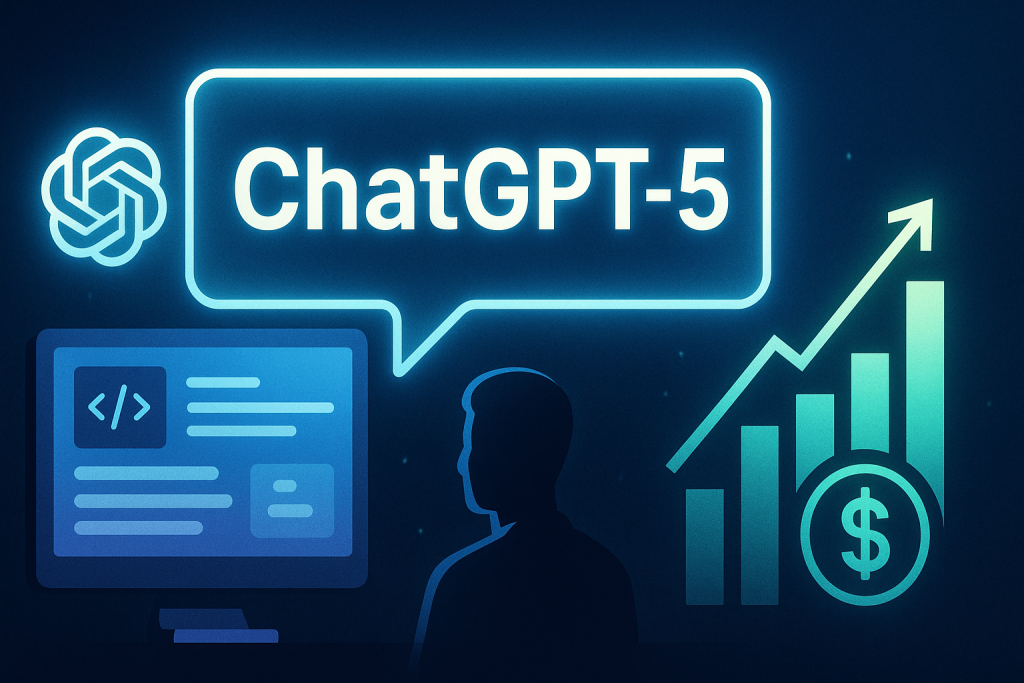Why ChatGPT-5’s Stunning Launch Is Bad News for Many AI Stocks

Last week’s launch of ChatGPT-5 was a jaw-dropper — even in an industry where “mind-blowing” has become routine.
The new flagship model from OpenAI isn’t just incrementally better than its predecessors. It’s best-in-class on multiple AI intelligence benchmarks while running on surprisingly low compute. Translation: it’s not only smarter than essentially everything else in the market, it’s also faster and cheaper to run.
One demo in particular sent shockwaves through the tech world: a user asked ChatGPT-5 to build a custom language-learning app. In seconds, it was done — functional, polished, deployable. No human developer needed.
Investors cheered. AI stocks broadly ticked higher. After all, a leap forward like this should be rocket fuel for the AI economy: more capable models → more compelling AI applications → more adoption, usage, and revenue for AI companies.
And that’s true… mostly.
When AI Gets Too Good, It Becomes the Competition
The uncomfortable truth is that ChatGPT-5 — and soon Grok 4, Gemini Ultra 2, Claude Next, and other foundational AI “supermodels” — aren’t just enablers for other software companies. They’re competitors.
ChatGPT-5 marks a seminal moment — a crossing of the Rubicon. Foundational AI models are now so capable they can compete directly with many enterprise AI software platforms.
The ability to spin up a language-learning app in seconds? That’s potential new competition for Duolingo (DUOL).
With capabilities like this, we’re entering a new era of BYO AI — “bring your own AI” tools. Instead of paying for specialized software to do a specific job, users (especially small and mid-sized businesses) can point a general-purpose AI at the problem and let it do the work.
- Why license a costly marketing automation suite when ChatGPT-5 can take your data, campaign goals, and style guide — and run it?
- Why pay for a website builder when you can simply describe your business to an AI and get a production-ready site instantly?
- Why buy entry-level BI tools when you can upload your data and have AI visualize, analyze, and report?
The rapid improvement in foundational AI models means many entry-level enterprise software companies face the same kind of existential threat that entry-level human workers have been facing for the past 18 months.
The disruptors are becoming the disrupted — and it’s happening at light speed.
The SMB Risk Factor
This risk isn’t equally distributed. Large enterprises still have strong reasons to buy from specialized vendors — compliance, security, integration, governance, and the desire to avoid mission-critical workflows being run on ungoverned AI assistants.
But for small and mid-sized businesses, the math is obvious:
- $40/month for ChatGPT Plus
vs. - $1,000+/month for a specialized suite that ChatGPT can now replicate
If you’re running a 15-person marketing agency, boutique e-commerce shop, or regional construction firm, BYO AI will look irresistible.
Highest wipeout risk: entry-level enterprise software vendors with heavy SMB exposure.
We’re already adjusting our model portfolios in light of this shift.
Where We See Notable Risk
Website Builders
Project Management & Collaboration
- Asana (ASAN) – Task automation replicable in ChatGPT.
- Dropbox (DBX) – AI file search is commoditized.
- Box (BOX) – Document workflows could go GPT-native.
Marketing Software
- Sprinklr (CXM) – Social analytics edge erodes if AI can analyze and respond across platforms directly.
- Braze (BRZE) – Event orchestration moat narrows as AI goes agentic.
- Semrush (SEMR) – SEO/content tools at high risk from GenAI.
- The Trade Desk (TTD) – AI reduces “open web” traffic (which TTD depends on) and enables direct ad buys (or automate campaigns themselves) without going through a DSP like Trade Desk.
Business Intelligence / CRM / HR
- Domo (DOMO) – Dashboards are early AI casualties.
- HubSpot (HUBS) – More defensible, but SMB-heavy exposure keeps risk elevated.
- Paycom (PCOM) – Payroll is sticky, but HR/talent modules could be eaten by AI.
- UiPath (PATH) – RPA tasks can often be done directly via GPT with APIs.
Who’s Safe (For Now)
Defensible AI stocks share at least one of these:
- Deep enterprise integration
- Proprietary, inaccessible data
- Industry-specific compliance requirements
- Hardware + software moats
We still like:
- Big Fish: ServiceNow (NOW), Salesforce (CRM), Palantir (PLTR), Atlassian (TEAM), Intuit (INTU) — entrenched in large orgs with high switching costs.
- Specialists: Autodesk (ADSK), Samsara (IOT), Guidewire (GWRE), Vertex (VERX), Q2 (QTWO) — vertical moats and regulatory/data complexity.
- Infra Layer: JFrog (FROG), GitLab (GTLB), Snowflake (SNOW) — AI is an adoption driver, not a threat.
The Narrowing of the AI Boom
A year ago, every software company with “AI” on its homepage got a valuation bump — regardless of defensibility or quality.
That era is over.
Now, capability concentration is the game. Gains are consolidating into a few real AI innovators, disruptors, and moat-builders. Everyone else — even last year’s high-flyers — risks falling into the “everything else” economy.
The market’s catching on. In the past month, several former AI darlings have been hit hard — not because AI is slowing down, but because it’s speeding up past them.
How to Play It
We need to adapt just as quickly as the technology is evolving. That means:
- Reduce exposure to SMB-heavy, entry-level enterprise software names.
- Double down on large-cap incumbents with defensible moats.
- Own the infrastructure layer AI depends on.
- Focus on proprietary data and industry lock-in.
The faster AI advances, the fewer AI stocks are worth owning. ChatGPT-5 makes the strong stronger — and exposes the weak.
Don’t get caught holding yesterday’s disruptors as they become today’s disrupted.
Adapt. Evolve. Stay invested in companies that will matter in five years, not just five months.









